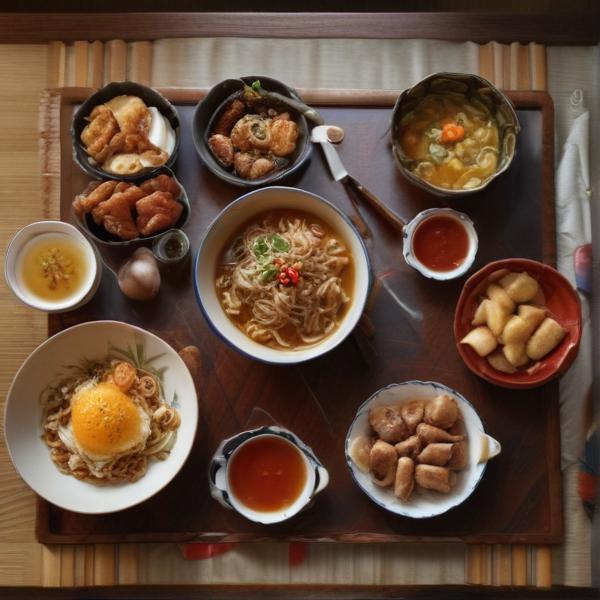基本信息 (Basic Information)
含义与用法 (Meanings & Usage)
中文核心释义 (Core Chinese Meaning): 吃饭,进食;食物。
英文核心释义 (Core English Meaning): to eat; food
象形意义 / 为何这么写 (Pictographic Meaning / Writing Rationale)
文言文释义 (Classical Chinese Meaning)
与现代意义相近,主要表示吃、饮食或食物。Similar to modern meaning; mainly refers to eating, diet, or food.
深入学习 (In-depth Study)
字源故事 (Origin Story)
字形演变 (Character Evolution)
常用词语和例句 (Common Words & Examples)
食品 (food product, food; groceries)
超市里有各种各样的食品。
Eng: There are many kinds of food products in the supermarket.
食物 (food)
我们需要健康的食物来保持身体健康。
Eng: We need healthy food to stay healthy.
食堂 (canteen, cafeteria)
中午我们去食堂吃饭吧。
Eng: Let's go to the canteen for lunch at noon.
相关成语 (Related Idioms)
食不下咽
Meaning: unable to eat due to worry or anxiety
多语言翻译 (核心释义) (Translations (Core Meaning))
- French: manger; nourriture
- German: essen; Essen
- Spanish: comer; comida
- Italian: mangiare; cibo
- Portuguese: comer; alimento
- Russian: есть; еда
- Arabic: يأكل؛ طعام
- Persian: خوردن؛ غذا
- Dutch: eten; voedsel
- Polish: jeść; jedzenie
- Vietnamese: ăn; thức ăn
- Ukrainian: їсти; їжа
视频学习资源 (Video Learning Resources)
通过以下链接在热门视频网站搜索 "食" 的更多讲解:
Search for more explanations of "食" on popular video sites:
- 在 Bilibili.com 搜索 "食 字源 说文解字" (Search on Bilibili)
- 在 YouTube.com 搜索 "食 character origin etymology" (Search on YouTube)
网络参考 (Web References for "食") ()
网络内容摘要 (Web Content Summary):
-
核心含义:“食”是汉语中常用字,基本含义包括“吃”(动词)和“食物、饭食”(名词)。 Core meaning: "食" is a common Chinese character, meaning "to eat" (verb) and "food, meal" (noun).
-
象形起源:“食”最早见于甲骨文。古字形下部像盛有食物的容器,上部像盖子,也有解释为张口要吃的嘴,表示进食的动作,体现人与食物的关系。 Pictographic origin: The earliest "食" appears in oracle bone script. The lower part resembles a food container, and the upper part is like a lid (or an open mouth), suggesting the act of eating and the connection between people and food.
-
有趣的文化背景:“食”字源自人类日常生活中最基本的需要,涉及温饱和社会礼节,体现中国饮食文化的重要性。 Cultural background: The character originates from people's fundamental need to eat, reflecting both survival and social etiquette. It highlights the significance of food culture in China.
-
特别用法:“食”可以作动词或名词,还用于比喻,如“日食”(solar eclipse)、“月食”(lunar eclipse),表示遮蔽现象。 Special usages: It functions as a verb or noun, and is metaphorically used in words like “日食” (solar eclipse) and “月食” (lunar eclipse), showing the meaning of covering or obscuring.
-
常用词语与成语:常见词有“食品”(food)、“餐食”(meal)、“饮食”(diet),成语如“民以食为天”(People regard food as their heaven, meaning food is people's primary need)。 Common words and idioms: Examples include “食品” (food), “饮食” (diet), and the idiom "民以食为天" ("The people regard food as their primary need.").
-
易混淆点:“食”有多音,如“shí”(最常用的读音,吃)、“sì”(如“食堂”中,部分地区用音)、“yì”(较少用)。 Note on pronunciation: Multiple readings exist, with “shí” being most common ("to eat"), while “sì” and “yì” occur in specific words or regions.
汉字"食"的起源、演变过程-汉字字源辞典
皀 ,既是声旁也是形旁,表示装在豆器里的香喷喷的白米饭。 食 ,甲骨文 (朝下的 " 口 " ,低头吃东西 ) (皀, 装在豆器里的香喷喷的白米饭 ),表示低头吃饭。 有的甲骨文 省去表示热气的两点 。 金文 承续甲骨文字形。 有的金文 将豆器中的白米饭 " 皀 " 写成 。 篆文 误将金文字形中 ...
食(汉语文字)_百度百科
食(拼音:shí,sì,yì)是汉语一级通用汉字(常用字)。此字始见于商代甲骨文,其古字形下部像盛满食物的器皿,上部像盖。一说上部像口,会张口就食之意。食的本义有动、名两用,作动词指进食,吃,作名词义是食物,主要指饭食、粮食。由吃义引申为享受,又由比喻而引申为日食、月食 ...
更多图片 (食 More Images) ()
